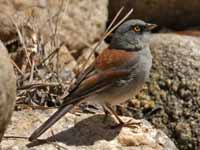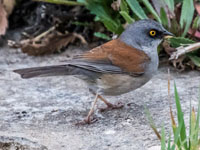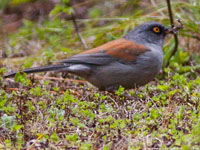THE WORLD BIRDS - An Online Bird Book
PASSERELLIDAE
Order Passeriformes Family Passerellidae
PASSERELLIDAE
The Passerellidae family includes New World brush-finches, juncos, New World sparrows, and towhees. These species were formerly included in the Emberizidae faimiy which now only contains the Old World buntings, They are small seed-eaters with a finch-like bill. In addition to seeds they also eat insects, especially when feeding their young. They build cup-shaped nests.
Juncos
Order Passeriformes Family Passerellidae
A junco is a small North American bird. Their breeding habitat is coniferous or mixed forest areas throughout North America and dry areas are favored. In winter norrthern birds migrate and they often forage in flocks. They eat mainly insects and seeds, foraging on the grond. They usually nest in a well-hidden location on the ground or low in a shrub or tree.
Genus Junco
Junco, Baird's Junco bairdi
Description: The Baird's junco has a rufous mantle fading to brown on the rump and upper-tail. It has a grey head with yellow eyes. The flanks are rufous and the rest of the underparts are whitish. The Baird's junco is about 15 cm long.
Range: Southern Baja California Peninsula in Mexico.
Habitat: Forests in the Sierra de La Laguna mountain range.
Diet: Mainly seeds; also insects.
Conservation status: Least Concern.
Image by: 1) dgalindo 2) _Amy_McAndrewsRange: Southern Baja California Peninsula in Mexico.
Habitat: Forests in the Sierra de La Laguna mountain range.
Diet: Mainly seeds; also insects.
Conservation status: Least Concern.
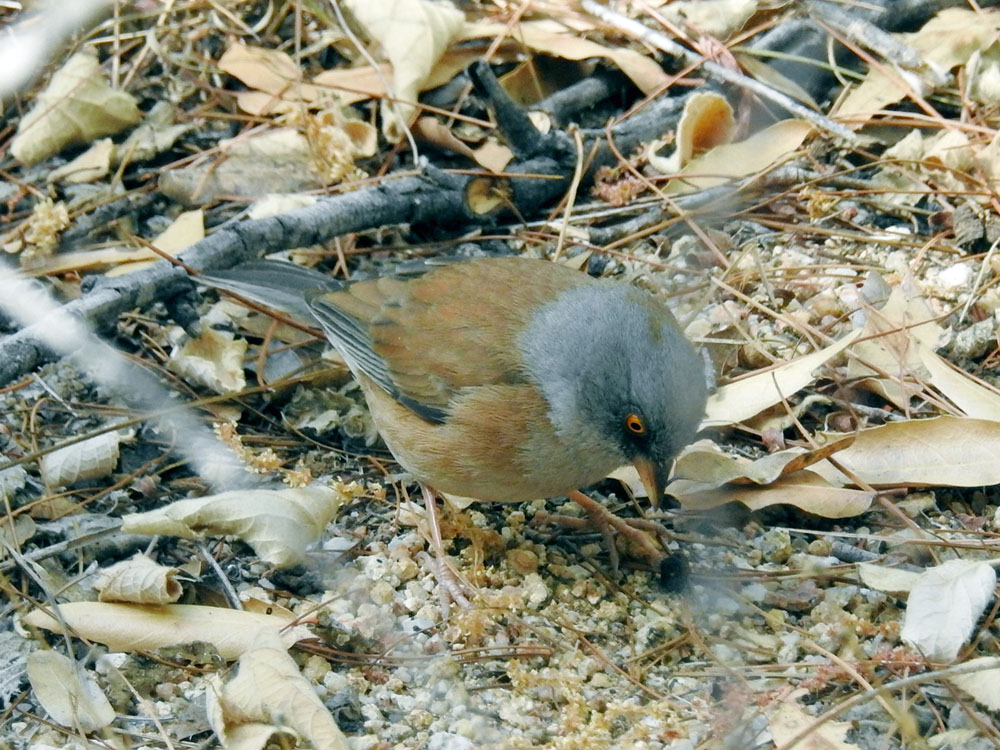

Junco, Dark-eyed Junco hyemalis
Description: The dark-eyed junco has a grey head, neck,and breast. It has a pink bill. The back and wings are grey or brown. It has a white belly. There is much variation in the plumage details.
Range: North America.
Habitat: Most locations except dense forest and wetlands.
Diet: Seeds, insects, spiders.
Conservation status: Least Concern.
Image by: 1, 2) Alan D. Wilson - British Columbia 3) J. N. Stuart - New Mexico 4 John Breitsch - Colorado 5) Dick - New Hampshire 6) Dick Daniels - North Carolina Range: North America.
Habitat: Most locations except dense forest and wetlands.
Diet: Seeds, insects, spiders.
Conservation status: Least Concern.
1, 2) Oregon 3) Pink-sided 4) White-winged) Slate-colored
1) Male 2) Female 5) Juvenile
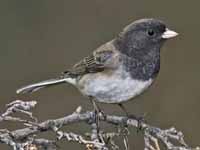
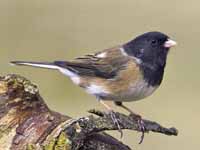
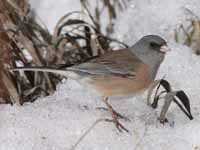
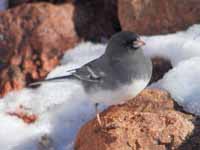

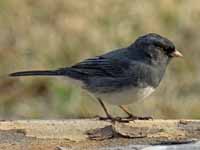
Junco,_Guadalupe Junco insularis
Description: The Guadalupe junco has brown upperparts with blackish wings and tail. It has a greyish head. The upper-breast is also greyish and the rest of underparts are whitish. The Guadalupe junco is about 14 cm long. At one time it was considered to be a subspcies of the dark-eyed junco, but it is smaller, has a longer bill, and has a unique song.
Range: Guadalupe Island (off west coast of Mexico).
Habitat: Cyprus groves and stands of pine.
Diet: Insects, seeds.
Conservation status: It is listed as ENdangered because of over-grazing by goats, Also, predation by feral cats has played a major role.
Image by: 1) Pau_Aleixandre Range: Guadalupe Island (off west coast of Mexico).
Habitat: Cyprus groves and stands of pine.
Diet: Insects, seeds.
Conservation status: It is listed as ENdangered because of over-grazing by goats, Also, predation by feral cats has played a major role.
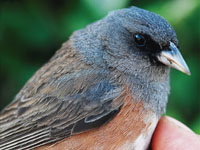
Junco,_Volcano Junco vulcani
Description: The volcano junco has brown upperparts with dark streaks. Unlike other species, this junco has no white on the tail. It has a grey head with a black mask and yellow eyes.The legs and bill are pink; underparts are grey.
Range: Costa Rica, Panama.
Habitat: Grassy and / or shubby areas. Usually above 2500 meters; many of the sites are on volcanos
Diet: Seeds, berries, insects, spiders.
Conservation status: Least Concern.
Image by: 1) Muchaxo - Costa Rica 2) Tom Benson - Costa Rica 3) Don Faulkner - Costa Rica 4) Nick Athanas - Costa RicaRange: Costa Rica, Panama.
Habitat: Grassy and / or shubby areas. Usually above 2500 meters; many of the sites are on volcanos
Diet: Seeds, berries, insects, spiders.
Conservation status: Least Concern.
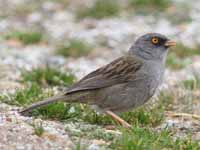
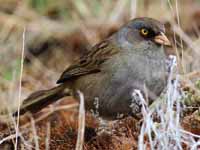
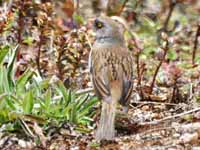
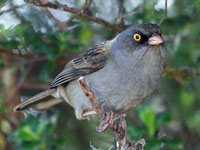
Junco,_Yellow-eyed Junco phaeonotus
Description: The yellow-eyed junco has a rufous back including some rufous on the folded wings. It has yellow eyes surrounded by a black mask. The rest of the plumage is grey with the underparts pale. The bill is bicolored.
Range: Mainly Mexico. Also Arizona, New Mexico
Habitat: Open montane woodlands.
Diet: Seeds, berries, insects, spiders.
Conservation status: Least Concern.
Image by: 1) Mike and Chris 2) 666isMONEY 3) Nick Athanas - Mexico 4) Ron Knight - MexicoRange: Mainly Mexico. Also Arizona, New Mexico
Habitat: Open montane woodlands.
Diet: Seeds, berries, insects, spiders.
Conservation status: Least Concern.
